The Paag is a headdress in the Mithila region of India and Nepal worn by Maithil people. It is a symbol of honour and respect and a significant part of Maithil culture. [1]
Contents

The Paag is a headdress in the Mithila region of India and Nepal worn by Maithil people. It is a symbol of honour and respect and a significant part of Maithil culture. [1]

The Paag dates back to pre-historic times when it was made of plant leaves. [2] It exists today in a modified form. The Paag is considered as a symbol of pride in Mithila. [3] The colour of the Paag also carries a lot of significance. The red Paag is worn by the bridegroom and by those who are undergoing the sacred thread rituals. Paag of mustard colour is donned by those attending wedding ceremonies and the elders wear a white Paag. [4]
A campaign to promote use of the paag was begun in 2016 by Mithilalok, a Mithila cultural pressure group set up in that year. Called Paag Bachau Abhiyan (Save the Paag Campaign), Mithilalok was associated with a proposed symbolic wearing of the garment by some representatives in the Bihar Legislative Council in August 2016, and also with a move to have it recognised as an official head-dress of the state of Bihar. [5]
Darbhanga MP Gopal Jee Thakur has started and popularised the tradition of honouring people with Mithila Paag in the Indian Politics.
Paags designed and developed by Mithilalok are of different shades, colours and shapes considering fitting and suitability.
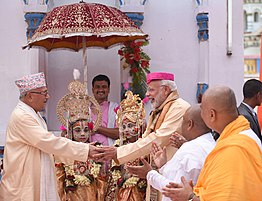
In order to demonstrate and send across the message of the Culture of Mithila and India, Paag March is held by Mithilalok wherein a large number of people take to streets wearing traditional Paag on their heads. [5]
On 10 February 2017, India Posts released a set of sixteen commemorative postage stamps on "Headgears of India". The Mithila Paag was featured on one of those postage stamps. [2]

Mithila is a proposed state in India, comprising the Maithili speaking region of Bihar and Jharkhand. The Maithili language has own traditional script, known as Mithilakshar. It is part of the historical Mithila region. The proposed state will also include Whole Angika and Bajjika speaking districts which are considered to be dialects of Maithili. What will be the capital city of Mithila, India is still to be decided. Historically the capital cities of Mithila have shifted between Janakpur (Nepal), Vaishali, Simraungadh (Nepal), Rajnagar (Madhubani) and Darbhanga to now Begusarai.
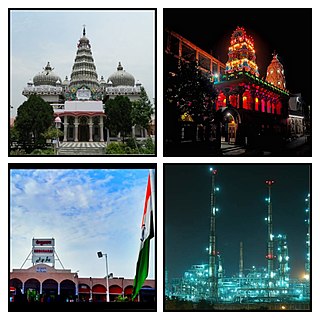
Begusarai is the industrial and financial capital of Bihar and the administrative headquarters of the Begusarai district, which is one of the thirty-eight districts of the Indian state of Bihar. The district lies on the northern bank of the river Ganges in the Holy Mithila region of India.
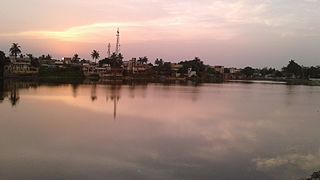
Araria district is one of the thirty-eight districts of Bihar state, India. Araria district is a part of Purnia division. The district occupies an area of 2,830 km2 (1,090 sq mi). Araria town is the administrative headquarters of this district.

Lalit Narayan Mishra was an Indian politician who served as Minister of Railways in the government of India from 1973 to 1975. He was brought into politics by the first Chief Minister of Bihar, Krishna Sinha, when he was made parliamentary secretary at his insistence to the First Prime Minister of India, Jawaharlal Nehru. In 1975, he died in a bomb blast at Samastipur railway station. The court case was delayed for years and was finally completed in December 2014.
Maithils, also known as Maithili people, are an Indo-Aryan ethno-linguistic group from the Indian subcontinent, who speak the Maithili language as their native language. They inhabit the Mithila region, which comprises North Bihar and parts of Jharkhand in India and some adjoining districts of Nepal constituting Madhesh Province. The Maithil region forms an important part of Hinduism as it is said to be the birthplace of Sita, the wife of Ram and incarnation of Lakshmi.
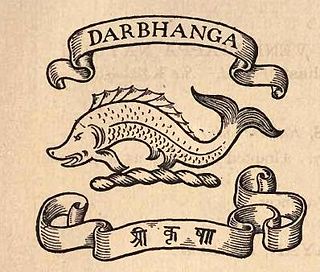
The Darbhanga Raj, also known as Raj Darbhanga and the Khandwala dynasty, was a Maithil Brahmin dynasty and the rulers of territories, not all contiguous, that were part of the Mithila region, now divided between India and Nepal.
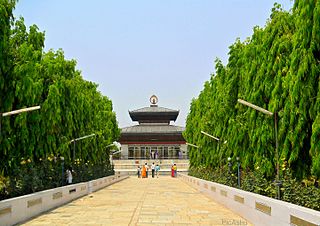
Mithila, also known as Tirhut, Tirabhukti and Mithilanchal is a geographical and cultural region of the Indian subcontinent bounded by the Mahananda River in the east, the Ganges in the south, the Gandaki River in the west and by the foothills of the Himalayas in the north. It comprises certain parts of Bihar and Jharkhand of India and adjoining districts of the Province No. 1, Bagmati Pradesh and Madhesh Province of Nepal. The native language in Mithila is Maithili, and its speakers are referred to as Maithils.
Mithila is a geographical and cultural region located in the Indian subcontinent. It comprises certain parts of Bihar of India and adjoining districts of the eastern Terai of Nepal. The native language is known as Maithili and its speakers are referred to as Maithils. The majority of the Mithila region falls within modern-day India, more specifically in the state of Bihar. Mithila is bounded in the north by the Himalayas, and in the south, west and east by the Ganges, Gandaki and Mahananda respectively. It extends into the southeastern Terai of Nepal. This region was also called Tirabhukti, the ancient name of Tirhut.
Mithila culture or Maithil culture refers to the culture which originated in the Mithila region of the Indian subcontinent. Mithila comprises Tirhut, Darbhanga, Kosi, Purnia, Munger, Bhagalpur and Santhal Pargana divisions of India and adjoining provinces of Province No. 1, Bagmati Pradesh, and Madhesh Province of Nepal.
This article deals with the system of transport in Bihar, both public and private.
Bihari culture refers to the culture of the Indian state of Bihar. Bihari culture includes Mithila culture, Bhojpuri Culture and the culture of Magadha.

Navlakha Palace, also known as Rajnagar Palace, is a royal Brahmin palace in the town of Rajnagar, near Madhubani in Bihar, India. The palace was built by Maharaja Rameshwar Singh of Darbhanga.
Pagri, sometimes also transliterated as pagari, is the term for turban used in the Indian subcontinent. It specifically refers to a headdress that is worn by men and women, which needs to be manually tied. Other names include sapho.
The Patna Half Marathon has been jointly conceptualized by NCC Dte Bihar & Jharkhand and the Department of Art, Youth & Culture to commemorate 75 years of India’s Independence (Azadi Ka Amrit Mahotsav) and 50 years of glorious victory in the Indo-Pak war, 1971 (Swarnim Vijay Varsh).
National Alliance of People's Movements is an alliance of alter-globalisation activist groups in India. It is an umbrella organisation for various civil society organisations and individuals working towards similar goals.
Dumaria is a Block in Gaya District of Bihar State, India. It belongs to Magadh Division. It is located 83 km towards west from District headquarters Gaya. 175 km from State capital Patna towards North. Dumaria Block is surrounded by Hariharganj Block towards west, Imamganj Block towards East, Chhatarpur Block towards west, Deo Block towards North. Aurangabad City, Hussainabad City, Sherghati City, Rafiganj City are the nearby Cities to Dumaria. Dumaria is a Naxalite movement affected area since 1980s. Dumaria consist of 100 villages and 11 panchayats. Lonchak is the smallest village and Kolhubar is the biggest village. It is at 93 m elevation (altitude). Magadhi is the local language here. Also people speak Hindi, Urdu, and English. Total population of Dumaria Block is 100,411 living in 15,531 houses, spread across total 100 villages and 12 panchayats. Males are 51,326 and females are 49,085.

Madhesh Province is a province of Nepal that was formed after the adoption of the Constitution of Nepal. It is Nepal's most populous province, and smallest province by area. It borders Province No. 1 to the east, Bagmati Province to the north, and India’s Bihar state to the south. It has an area of 9,661 km2 (3,730 sq mi)-about 6.5% of the country's total area. It has a population of 6,126,288 as per the 2021 Nepal census, making it the most populated province of Nepal.
The Mithilalok Foundation is an India-based social service organization that works to promote socio-cultural and economic development of the Mithila region. The flagship programme it has is Paag Bachau Abhiyan .
Choudhary Kedarnath Thakur was the Zamindar of Singhwara Estate. The estate situated in the Darbhanga district of Mithila in Bihar. He belonged to the Zamindar Family of Mithila (region). He held his title over his family estates in the Singhwara when such titles were abolished following the Independence of India.

Mithila State Movement is a 300-year-old movement advocating a separate Mithila state in India. This movement gained momentum in 1902 AD when Sir George Grierson, an official of the British Indian government, prepared a map of Mithila state by conducting a language-based survey. In 1881 AD, the word Mithila was added to the dictionary of the British India government. According to the founder, president Dr. Dhanakar Thakur of the International Maithili Council in the proposed Mithila state, 24 districts of Bihar and six districts of Jharkhand, a total of 30 districts, have been included, which has a population of about 70 million. At the same time, the area is 70 thousand square km.